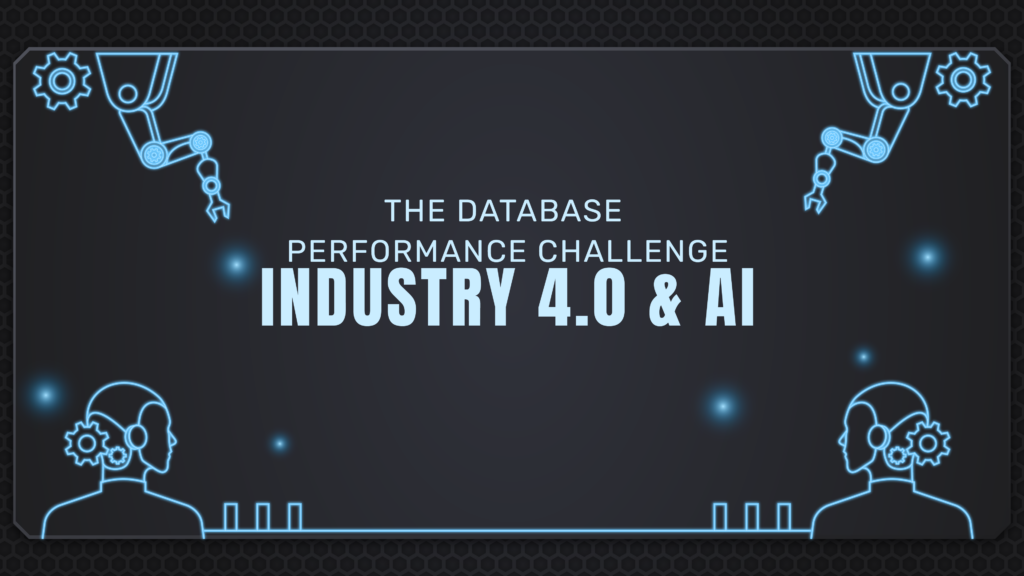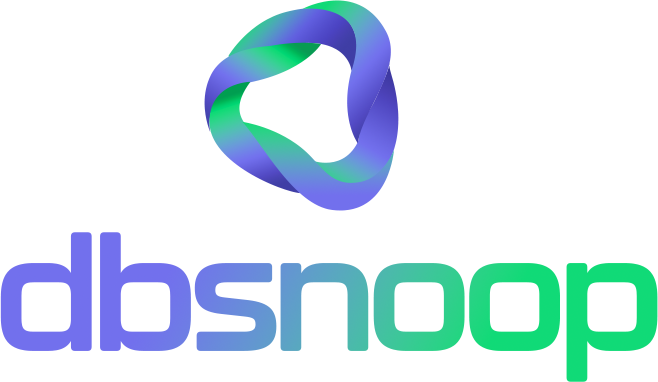

An unscheduled stop on the production line. A batch of defective products identified only at the end of the process. A supply chain bottleneck that no one predicted. For DevOps, SREs, and DBAs working in the manufacturing world, these scenarios are sources of high pressure and stress. The root cause? Often, a vague and hard-to-diagnose “system problem.” In Industry 4.0, where IoT sensors generate terabytes of data every second and Artificial Intelligence algorithms need real-time answers to control production, the data infrastructure is not just a support system; it is the central nervous system of the entire operation.
The transition to smart manufacturing is not about installing more robots or collecting more data. It’s about the ability to process, analyze, and act on that data with surgical speed and precision. And at the heart of this capability lies the database. Any latency, any poorly optimized query, or cloud scalability failure can mean the difference between an optimized operation and a loss of millions. For the technical professionals responsible for keeping this engine running, the pressure is immense, and traditional monitoring tools are no longer sufficient. It is necessary to go beyond; it is necessary to have observability.
The Silent Revolution of Industry 4.0: More Data, New Challenges
The Fourth Industrial Revolution, or Industry 4.0, represents a fundamental paradigm shift. It is defined by the fusion of the physical, digital, and biological worlds, driven by technologies such as Artificial Intelligence (AI), the Internet of Things (IoT), cloud computing, and Big Data. In factories, this translates into a hyper-connected ecosystem where machines, systems, and people communicate constantly.
The Data Big Bang: IoT, Sensors, and the Pressure on Infrastructure
The modern factory floor is a massive data generator. Vibration sensors in motors, computer vision cameras for quality control, RFID readers in logistics—all produce a volume of information that can reach zettabytes annually on a global scale. This data explosion, while being the fuel for AI and automation, places unprecedented pressure on the IT infrastructure, especially on databases.
The main data sources in smart manufacturing include:
- Machine Sensors (IIoT): Collect real-time data on temperature, pressure, vibration, energy consumption, and other operational parameters.
- Manufacturing Execution Systems (MES): Manage and monitor work-in-progress on the factory floor.
- Enterprise Resource Planning (ERP) Systems: Integrate data from across the organization, from order to delivery.
- Supply Chain Data: Information on suppliers, logistics, and inventory.
Collecting this data is just the first step. For AI to be able, for example, to predict a failure in a piece of equipment, it needs to access and process historical and real-time data almost instantly. This requires a robust, scalable, and, above all, high-performance data architecture.
Why Does the Traditional Monitoring Approach Fail in Industry 4.0?
DevOps and SRE teams know that monitoring a complex environment is no easy task. However, Industry 4.0 elevates this complexity to a new level. The traditional approach, focused on dashboards that show the health status of isolated components (CPU usage, memory, disk space), is reactive and insufficient. It might tell you what broke, but it rarely explains why.
In this new scenario, problems are not linear. A slight slowness in a database query can cause a cascading effect, delaying the analysis of an AI algorithm, which in turn may fail to identify a quality defect, resulting in significant financial losses. Traditional monitoring cannot connect these dots. It doesn’t offer the necessary context for fast and effective troubleshooting, leaving teams in a constant cycle of “firefighting.” This is where observability becomes crucial.
The Critical Role of the Database in Smart Production
If AI is the brain of the smart factory, the database is its heart. It pumps the vital information that allows all other technologies to function. Inadequate database performance can compromise the entire promise of efficiency and automation of Industry 4.0.
Ensuring Performance for Real-Time Decisions
Decision-making in Industry 4.0 is increasingly automated and data-driven. AI algorithms adjust machine parameters in real time to optimize energy consumption, computer vision systems decide in milliseconds whether a product meets quality standards, and logistics are dynamically recalculated based on traffic and production data.
All of this depends on database queries that must be executed with minimal latency. A query that takes a few extra seconds to run might be unnoticeable in an e-commerce system, but on an automated assembly line, it can cause a complete stop. For DBAs and developers, this means that query optimization, correct indexing, and efficient database schema design are no longer best practices—they become critical business requirements.
Scalability and Data Management: The Cloud Challenge in Manufacturing
Cloud computing is an essential enabler of Industry 4.0, offering the flexibility and computational power needed to store and process large volumes of data. However, migrating and managing industrial databases in cloud environments (public, private, or hybrid) brings its own challenges.
Teams need to ensure that the data architecture is elastic enough to handle peaks in data generation, such as during a high-production shift, without incurring exorbitant costs. The management of data sovereignty, network latency between the factory floor (edge) and the cloud, and the complexity of managing distributed databases are constant concerns for Tech Leads and SREs.
Data Security: Protecting the Heart of the Operation
With the hyper-connectivity of Industry 4.0, the attack surface for cyber threats increases exponentially. Production data are extremely valuable and sensitive assets. A leak can expose trade secrets, and a ransomware attack can paralyze the entire factory operation.
Database security is a fundamental pillar of this protection. This goes beyond firewalls and access control. It involves constant auditing of who accesses the data, detecting anomalies in query patterns that could indicate an internal or external threat, and ensuring compliance with regulations like GDPR. For the security and DevOps team, ensuring data integrity and confidentiality is a mission-critical responsibility.
Observability as a Pillar of Automation and Reliability (The SRE Mindset in the Factory)
While traditional monitoring asks, “is the system working?”, observability allows you to ask, “why isn’t the system working as it should?”. Site Reliability Engineering (SRE), a discipline born at Google, brings this mindset to operations, focusing on automation and the precise measurement of reliability to ensure system stability. In Industry 4.0, adopting an SRE mindset is essential to tame the complexity.

Beyond Monitoring: Understanding the ‘Why’ of Failures
Observability is based on three main pillars: logs, metrics, and traces. By correlating these three data sources, teams can get a complete and contextualized view of the system’s behavior.
Imagine a scenario where production slows down.
- Metrics (what): Dashboards show an increase in application latency.
- Logs (where): Event records point to errors in a specific microservice.
- Traces (why): Distributed tracing shows the lifecycle of a request and reveals that a specific database query is the real bottleneck, impacting the entire flow.
This ability to go from symptom to root cause quickly is what sets observability apart. It transforms troubleshooting from a reactive and stressful process into a proactive and precise data analysis.
Proactive Troubleshooting: How AI Can Predict and Prevent Production Stoppages
The real game-changer happens when we combine observability with Artificial Intelligence. Advanced tools can analyze observability data in real time to detect patterns and anomalies that would be invisible to the human eye. This allows for predicting problems before they impact production. For example, an AI algorithm can identify a subtle degradation in a query’s performance over time and alert the DBA team before it becomes a critical issue. This is the foundation of predictive maintenance applied to the health of the data infrastructure.
The dbsnOOp Solution: Unifying the Vision of DevOps, SREs, and DBAs for Maximum Performance
It is precisely at this convergence point of database performance, observability, and AI that dbsnOOp operates. dbsnOOp is not just a monitoring tool; it is an intelligent observability platform designed for the database universe. It was created to solve the daily challenges of DBAs, developers, SREs, and DevOps teams who deal with complex, mission-critical data environments.
With dbsnOOp, teams can:
- Diagnose the Root Cause in Seconds: The platform goes beyond superficial dashboards, using AI to analyze query execution plans, automatically identify bottlenecks, and provide the necessary context for a precise diagnosis.
- Optimize Queries Intelligently: dbsnOOp not only points out the slow query but also suggests optimizations and generates ready-to-apply commands, drastically accelerating resolution time.
- Gain Complete Visibility: The platform offers a unified view of the health and performance of multiple databases, whether on-premises or in the cloud, breaking down the silos between teams.
Practical Cases: How AI and Observability Transform Production
The application of AI in industry, supported by a performant and observable database foundation, generates tangible and impressive results.
Predictive Maintenance: Preventing Failures Before They Happen
An automotive company uses sensors on its welding robots to collect vibration and temperature data. This data feeds an AI model that predicts the probability of a mechanical component failure. For this to work, the database must ingest and process thousands of readings per second. A platform like dbsnOOp ensures that the queries feeding this AI model run at maximum performance, guaranteeing that maintenance alerts are generated in time to prevent an assembly line stoppage, which can reduce maintenance costs by up to 30%.
Supply Chain Optimization with Real-Time Data Analysis
A large food distributor uses AI to optimize its delivery routes. The system analyzes real-time data on traffic, weather conditions, production status at factories, and inventory levels at distribution centers. The agility to recalculate routes and replenish stock depends on how quickly the database system can process these multiple sources of information. Observability here is key to ensuring that no bottleneck in the data infrastructure delays critical logistical decisions.
Automated Quality Control with Computer Vision
On an electronics production line, high-speed cameras capture images of each circuit board. an AI system compares these images with a “perfect” model to detect microscopic defects. Each image generates data that needs to be stored and accessed quickly for reference and analysis. The database’s performance directly impacts the speed of the production line. dbsnOOp helps ensure that the data infrastructure can keep up with the pace of automation, preventing defective products from reaching the consumer.
dbsnOOp: The Key Piece for Data Management in Your Transition to Industry 4.0
The transition to Industry 4.0 is a complex journey that requires more than the simple adoption of new technologies. It demands a cultural shift and a reassessment of the tools used to manage the infrastructure that supports innovation. For the technical teams on the front line, this means having the power of automation, intelligence, and visibility at their fingertips.
Intelligent Automation in Performance Diagnosis
dbsnOOp uses AI and Machine Learning to automate what was once a manual, time-consuming, and error-prone job. The platform learns the normal behavior of your database environment and proactively identifies deviations that indicate an imminent performance problem. It not only alerts but provides a clear diagnosis and practical recommendations, freeing up your team to focus on strategic initiatives instead of firefighting.
Complete Visibility of the Data Environment, from the Cloud to the Factory Floor
Whether your database is an on-premises MySQL, a PostgreSQL on AWS, or a SQL Server on Azure, dbsnOOp offers a unified control panel. This 360-degree view is essential for DevOps and SRE teams that need to manage complex, hybrid environments, ensuring that performance is consistent across the entire technology stack that supports the industrial operation.
Security and Compliance for Critical Industrial Data
dbsnOOp also acts as a security layer, providing auditing and visibility into data access and usage. In a sector where intellectual property and operational data are critical assets, having the ability to track and understand access patterns is fundamental for security and for compliance with data protection regulations.
Industry 4.0 is no longer the future; it is the competitive present. And in this scenario, the efficiency of your factory is directly linked to the health and performance of your data infrastructure. Ignoring the need for an intelligent observability platform for your databases is like trying to drive a Formula 1 car by looking only at the speedometer. You may know your speed, but you have no idea what’s happening with the engine, the tires, or the track ahead. dbsnOOp offers the complete cockpit, with real-time telemetry, intelligent diagnostics, and the recommendations your team needs to operate with maximum performance and reliability.
Want to solve this challenge intelligently? Schedule a meeting with our specialist or watch a live demo!
Schedule a demo here.
Learn more about dbsnOOp!
Learn about database monitoring with advanced tools here.
Visit our YouTube channel to learn about the platform and watch tutorials.

Recommended Reading
- AI Database Tuning: Real-time fraud detection requires a high-performance database infrastructure. This article explains how Artificial Intelligence is applied to optimize this foundation, ensuring the speed your AI models need to be effective.
- The Difference Between Log Monitoring and Real-Time Monitoring: The main article describes the shift from a reactive (rule-based) approach to a predictive (AI-based) one. This post delves into that philosophy, explaining why real-time monitoring is the only viable approach for detecting ongoing threats, in contrast to forensic log analysis.
- What does your company lose every day by not using AI?: This article serves as a strategic complement, broadening the discussion beyond fraud. It quantifies the daily losses in agility, cost, and innovation that companies face by not adopting AI in their operations, reinforcing the business case for your initiative.

